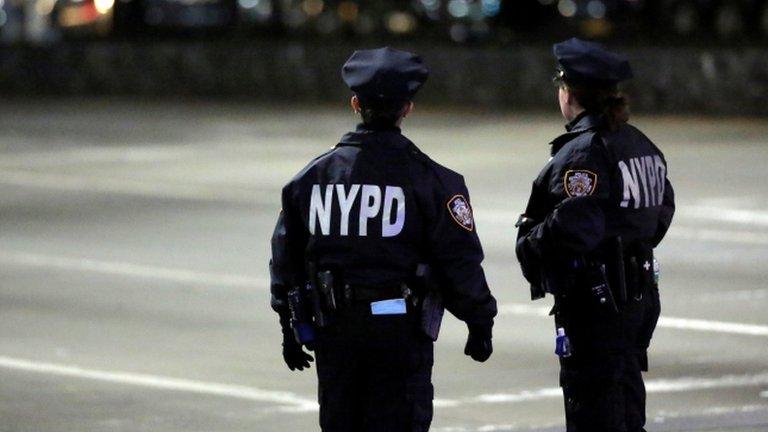Do New York police unfairly stop young black men?
- Published

An American civil liberties organisation has highlighted the controversial stop-and-frisk policing technique.
A post on the American Civil Liberties Union's (ACLU) Instagram page said the New York Police Department (NYPD) stopped more young black men than there are young black men living in the city.
What are the figures behind the ACLU's claim?
Stop and frisk, similar to stop and search in the UK, is part of the police effort to reduce violent crime in America's most populous city.
It gives police officers powers to stop someone suspected of committing a crime and permits officers to search someone if they suspect a concealed weapon.
The ACLU's claim isn't about New York City today though.

It comes from a 2011 report, external published by the organisation's New York branch. In that year, there were nearly 700,000 stops, according to police statistics.
The NYPD's data can be broken down into categories such as race, age and location. According to an ACLU analysis:
In 2011, half the people stopped were young - defined by the ACLU as between 14 and 24
There were 350,743 stops of black people (53%)
223,740 were Hispanic (34%)
61,805 were white (9%)
According to the figures, the number of young black men (aged 14 to 24) stopped by police exceeded the city's population of young black men - 168,126 stops compared with a population of 158,406. They used data from the 2010 American Community Survey (ACS).
In the following years, the number of police stops declined significantly. London experienced a comparable trend.

In 2013, during Mayor Michael Bloomberg's administration, a judge ruled that the way the practice was carried out in New York was unconstitutional and appointed a monitoring group to reform how the police carried out stops.
Judge Shira Scheindlin said the police department had resorted to a "policy of indirect racial profiling."
Her written opinion included the following details about nearly a decade of stop and frisks:
Between January 2004 and June 2012, the NYPD conducted more than 4.4 million stops
Half of all the stops were followed by a search of the person. A weapon was found after 1.5% of searches
12% resulted in arrest or a court summons
Weapons were found on 1% of the black people stopped, 1.1% of Hispanics, and 1.4% of white people
After the court ruling, the NYPD's stop-and-frisk guidance was amended. A ban on racial profiling is included in the police patrol guide.
The monitoring group's most recent report found that as the number of stops declined, a higher proportion of those stopped were being arrested.
Weapons were recovered from 25.8%, external of searches in 2015.
However, between 2012 and 2015 the report found that the percentages of stops of black, Hispanic and white people had remained roughly the same.
Last year, there were just under 11,000 stops in New York City.
The report noted that there are many factors that affect police stops such as levels of crime in certain areas and levels of street activity.



- Published4 April 2018

- Published12 August 2013
